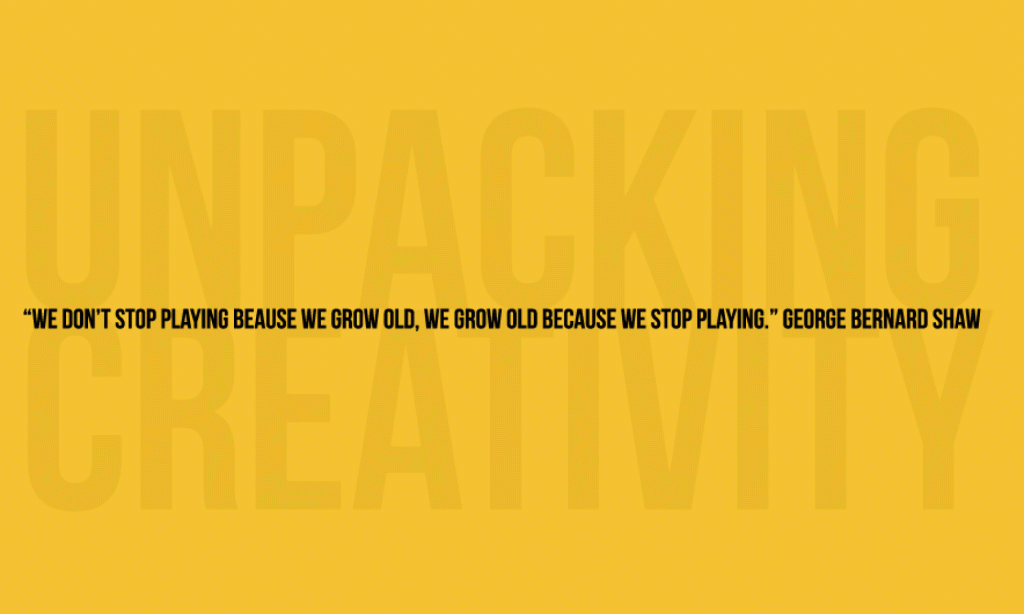Creativity, Innovation and imagination
“A common misconception is that creativity cannot be cultivated, and that instead some lucky people have an innate sense of creativity. But this assumption is wrong.” (Currie Le Cuff, 2023)
Back in 1963 George Land created a “creativity test” for Nasa that measured your imaginative thinking, the higher you scored the higher you were considered a “creative genius”. He tested 1600 4-5 years and every five years he re-tested them, until they became adults. The 4-5 year olds demonstrated 98% of creativity level while adults came down to 2%. As we grow older we lose our creativity, unless we work on it.

According to Land our brain has two different kinds of thinking: divergent where imagination generates new possibilities and convergent where testing, decisions and judgements occur.

In our school system we learn to do both kinds of thinking at the same time, this means that while we are creating we are also judging and pulling the brakes. “Neurons are fighting each other and we are diminishing the power of the brain.” (Le Brand 2011)
Our teachers, peers, adults and our own mind send us messages of doubt and criticism.

But why is creativity so important? Why now?
The obvious answer we are all currently talking about is artificial intelligence. There are machines that can write for us, draw for us, design for us and much more. The way we can differentiate ourselves from machines is through our imagination. Secondly, depression rates are higher than ever. “In 2020 the leading rate of death by 5-34 year olds was self harm” (Flinders, 2022). Creativity is linked to happiness. “Studies show that creativity leads to well being as well as wellbeing leads you to being more creative.” (Tan et al.)

What is creativity?
According the the Oxford Dictionary:
Creativity: the use of imagination or original ideas to create something; inventiveness.
Imagination: the faculty or action of forming new ideas, or images or concepts of external objects not present to the senses.
Innovation: make changes in something established, especially by introducing new methods, ideas or products.
I use all three definitions since creativity is many times linked to the arts while imagination and innovation are not.
So who needs to “learn” to be creative?
We are labeled from the moment we enter the school system – sometimes before. Creativity is associated with certain fields and if you don’t participate in those fields you are considered not creative. We are taught that STEM and the arts are two completely different worlds. We are told that you are not creative if you lean towards the sciences, when creativity truly applies in all fields. People that are labeled as not creative might not get the benefits. Our stakeholders are all the non- creatives of the world. Every human being that was “labeled” as not creative and that is not getting the benefits of innovation, imagination and creativity.
Can creativity be learned?
Creativity is said to be a muscle, we need to use it to keep it active. Ever since I was little I was labeled “creative”. My parents and teachers encouraged me to draw, paint, perform. I developed my creative “muscle” through classes, activities and even friendships.
In a recent study from the Yale Center for Emotional Intelligence published in the Empirical Studies in the Arts shows that children successfully learn creativity skills in a program focusing on emotions and emotional intelligence skills, this is also true in adults. (Ivcevic Pringle Ph.D.)
I have benefited from the advantages of learning to be imaginative. The change I want to see is for non creatives to benefit from expanding their creativity. I want to see creativity, imagination and innovation taught in every school for every person. I want creativity to not be linked to only the arts, and for people to understand its importance in our future world.
Works Cited
Aulive. “Free Online Creativity Test – TestMyCreativity.” Testmycreativity.com, 2019, www.testmycreativity.com/.
Big Wind Blows Game – Group Games, Team Games, Ice Breakers. www.group-games.com/ice-breakers/big-wind-blows-game.html. Accessed 27 Mar. 2023.
Borchardt, Sue. “Unlearning to Learn – Year End LILA Summit 2014.” Vimeo, 6 June 2014, vimeo.com/97547671. Accessed 27 Mar. 2023.
Cunff, Anne-Laure Le. “Combinational Creativity: The Myth of Originality.” Ness Labs, 16 Oct. 2019, nesslabs.com/combinational-creativity.
—. “The Science of Curiosity: Why We Keep Asking “Why.”” Ness Labs, 24 July 2019, nesslabs.com/science-of-curiosity.
Flinders, Sophie. “Mental Health.” The Nuffield Trust, 20 Jan. 2022, www.nuffieldtrust.org.uk/news-item/mental-health-indicator-update.
Ivcevic Pringle Ph.D., Zorana. “Creativity Can Be Taught.” Psychology Today, 9 June 2020, www.psychologytoday.com/gb/blog/creativity-the-art-and-science/202006/creativity-can-be-taught.
pmdtemp. “Flex Your Creativity Muscle – PMD Group.” PMD Group – Credit Union Marketing and Advertising, 1 Sept. 2015, www.pmdgrp.com/flex-your-creativity-muscle/. Accessed 16 Apr. 2023.
Project Zero. “Thinking Palette : Artful Thinking.” Pzartfulthinking.org, pzartfulthinking.org/?page_id=2.
“PZ’s Thinking Routines Toolbox | Project Zero.” Pz.harvard.edu, pz.harvard.edu/thinking-routines#ExploringArtImagesandObjects. Accessed 27 Mar. 2023.
Tan, Cher-Yi, et al. “Being Creative Makes You Happier: The Positive Effect of Creativity on Subjective Well-Being.” International Journal of Environmental Research and Public Health, vol. 18, no. 14, 6 July 2021, p. 7244, https://doi.org/10.3390/ijerph18147244. Accessed 16 Apr. 2023.
TEDx Talks. “TEDxTucson George Land the Failure of Success.” YouTube, 16 Feb. 2011, www.youtube.com/watch?v=ZfKMq-rYtnc.
“The Link between Creativity and Happiness (How Does It Work?).” Tracking Happiness, 2 Aug. 2021, www.trackinghappiness.com/link-between-creativity-and-happiness/.
“Universidad de Las Hespérides.” Universidad de Las Hespérides, hesperides.edu.es. Accessed 27 Mar. 2023.
